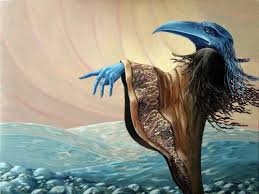Personal and Cultural Identity
ASSIGNMENT 4: The Trickster Archetype
|
Learning Target (Curricular Competencies):
|
Carl Jung first applied the term archetype to literature. He recognized that there were universal patterns in all stories and mythologies regardless of culture or historical period and hypothesized that part of the human mind contained a collective unconscious shared by all members of the human species, a sort of universal, primal memory. Recognizing archetypal patterns in literature brings patterns we all unconsciously respond to in similar ways to a conscious level. Source Return of the Trickster
Storytelling has always been a communal activity for First Nations. Traditionally, stories and legends brought people together to pass on their history to the next generation, to entertain each other, and to teach their children. They told stories about their ancestors, about every aspect of the land around them and about the magnificent beings who were part of their mythology.
One of the central figures in First Nations' mythologies is a character often referred to as the "Trickster". The Trickster can be either male or female. It is called different names in different First Nations' cultures — Raven by the people of the West Coast, Wee-sak-ee-chak by the Cree, Nana'b'oozoo by the Ojibway of the Eastern Woodlands, Kluskap by the Mi'kmaq. The Trickster is known as Coyote, Hare, Crow, Badger or Old Man among other First Nations in North America.
Generally, the Trickster is a half-human and half-spirit figure who roams from one adventure to another, assuming the form of animals or humans of either gender. The Trickster is an amusing character whose enormous curiosity frequently leads to trouble. The Trickster regularly displays contradictory behaviour such as charm and cunning, honesty and deception, kindness and mean tricks. It is unpredictable — one minute a hero, the next a foolish clown.
Above all, the Trickster is a teacher. Listeners are invited to draw their own conclusions about traditions and proper behaviour from the Trickster's exploits. The Trickster is a remarkably self-important individual. Like all humans, the Trickster is imperfect: it is capable of violence, deception and cruelty. Listeners learn as much through the Trickster's mistakes as through its virtues.
There are those who say that the Trickster left the First Nations when the Europeans arrived. Among the Ojibway, it is said that Nana'b'oozoo paddled away from his people in a canoe, accompanied only by his grandmother, upset that his people had rejected him for the ways of the newcomers. But it is also said that Nana'b'oozoo would return when the people were ready to welcome him again. Given the number of contemporary First Nations authors who employ the Trickster in their works, it appears that the Trickster has returned and is roaming the Canadian landscape once again.
One example of an archetype is The Trickster. There are many compilations of First Nations' myths and legends that feature the Trickster. Early translators of First Nations' myths and legends tended to modify the stories to resemble European fairy tales, with a linear plot and a moral. Contemporary versions of the Trickster stories better reflect the complexity and humour of the original storytellers.

Artist: Ron Stacy, Summerland,B.C. "I Shall Take These Stones"~Acrylic on Canvas
Tasks:
1. Read "The Shivering Tree" by John McLeod. Source
2. During or after your reading, open a word document title it 3.4 The Trickster Archetype, copy and paste the questions below and then answer them.
The Shivering Tree
John McLeod
- The Shivering Tree is a modern retelling of a trickster tale that reflects the oral tradition of Aboriginal mythology. The story offers an explanation of two natural phenomena. What are these natural phenomena?
- Based on this story, how would you describe the Trickster figure in Aboriginal mythology?
- What moral lesson can be drawn from the story? How is the story a cautionary tale?
- From what point of view is the story told? How does this contribute to the effectiveness of an oral story?
Assessment: Below you will find the exemplary criteria used to assess the assignment.
Learning Target: Exemplary (6/6): Exemplary comprehension of the task and clear accomplishment of the objective. Answers show an excellent understanding of the reading.
Written Expression: Exemplary (6/6): Sentence structure and vocabulary are varied, skillfully written, and carefully chosen. Work has been proofread and there are few or no errors in spelling, capitalization, punctuation, and grammar. Answers are detailed and include examples where required.
Submission
Use the "3.4 The Trickster Archetype" link on the main page of this section of the course to upload your assignment to your teacher for marking.